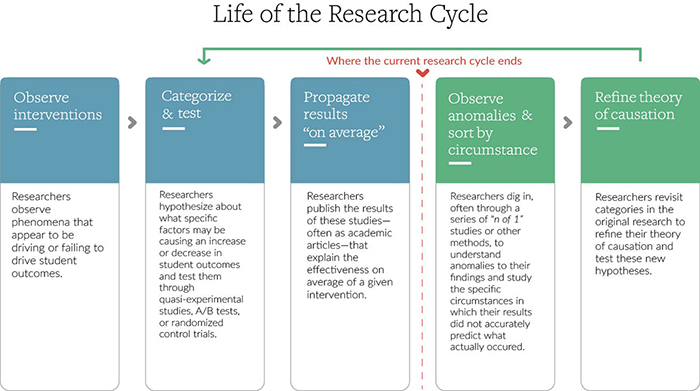Personalized learning is quickly gaining steam among educators, philanthropists, and policymakers. The promise of a personalized education system is enormous: we are witnessing an era when new school models and structures, often supported by technology, can tailor learning experiences to each student and allow students more choice in how they access and navigate those experiences.
But we’ve found that amidst the enthusiasm for personalized learning models, there’s a less talked-about aspect of the education system that will need to shift to make these models viable: education research.
Even though education receives paltry R&D dollars compared to other sectors, like defense and energy, there’s been a relatively steady stream of research over the past decades trying to look under the hood of “what works” in education. But if we are going to break open successfully the factory model of school, that research needs to go further.
In a new white paper out this week, “A blueprint for breakthroughs,” Michael Horn and I argue that simply asking what works stops short of the real question at the heart of a truly personalized system: what works, for which students, in what circumstances? Without this level of specificity and understanding of contextual factors, we’ll be stuck understanding only what works on average despite aspirations to reach each individual student (not to mention mounting evidence that “average” itself is a flawed construct). Moreover, we’ll fail to unearth theories of why certain interventions work in certain circumstances. And without that theoretical underpinning, scaling personalized learning approaches with predictable quality will remain challenging.
It bears noting that there is promising research on emerging personalized learning models, including, but not limited to, a RAND study published by the Bill & Melinda Gates Foundation last year and LEAP Innovations’ recently released personalized learning framework and corresponding survey instruments to analyze and refine personalized learning practices across schools over time. And more studies on topics not dubbed “personalized” continue to reveal crucial insights into how students learn best. For example, researchers, such as Daniel Willingham, have focused on describing and refining theories across the learning sciences (and, importantly, clarifying what those theories do and don’t explain).
More often than not, however, the traditional education research cycle stops short of surfacing the information we need to support high-quality personalized learning. For example, a recent federally funded randomized controlled trial (RCT) analyzing the efficacy of an adaptive math software program found that the software led to an average eight-percentile point gain among students. Although a thorough, well-funded study like this signals promise, findings like these do not reliably tell us why some portion of students or certain classes likely didn’t fare as well whereas others fared far better. A more complete cycle will move beyond finding what works best on average. Instead, those initial findings—often statements of correlation from A/B tests or RCTs—will be the starting point of a deeper inquiry into why certain approaches work for certain students. The graphic below illustrates the more complete research cycle that we lay out in the paper.

Our hope is that the research community can begin to coordinate a more complete research cycle in order to surface the breadth and depth of information needed to support personalized learning environments.
Otherwise, as more schools embrace personalized learning, at best each school will have to go at it alone and figure out by trial and error what works for each student. Worse still, if we don’t support better research, “personalized” schools could end up looking radically different but yielding similar results to our traditional system. In other words, we risk rushing ahead with promising structural changes inherent to personalized learning—reorganizing space, integrating technology tools, freeing up seat-time—without arming educators with reliable and specific information about how to personalize to their particular students or what to do, for which students, in what circumstances.
Researchers will be quick to point out that this issue is as much about funding shortfalls as it is about refining our methodological approach. We agree. A more complete approach to education research will take more R&D dollars, both public and private. We think that this upfront investment, however, is bound to pay off. In the long run, these dollars stand to save us from the enormous inefficiencies of a system that for too long has only known how to deliver learning on average. As we seize the opportunity to personalize learning truly, let’s make sure we are building a solid base of research on how to reach each student.

